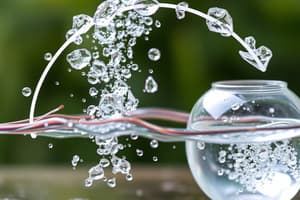Podcast
Questions and Answers
Which assessment tool primarily focuses on monitoring students' real-time application of key vocabulary and their descriptive abilities of the water cycle during collaborative activities?
Which assessment tool primarily focuses on monitoring students' real-time application of key vocabulary and their descriptive abilities of the water cycle during collaborative activities?
- Peer Feedback
- Observation Checklist (correct)
- Self-Assessment Form
- Water Cycle Diagram and Explanation
A student completes the statement 'I can describe the water cycle' and marks 'Quite Well'. According to the provided resources, what type of assessment is being utilized?
A student completes the statement 'I can describe the water cycle' and marks 'Quite Well'. According to the provided resources, what type of assessment is being utilized?
- Self-Assessment Form (correct)
- Observation Checklist
- Oral Presentation
- Peer Feedback
During a group activity, students are asked to evaluate each other's depictions of the water cycle using a rubric. What type of assessment does this represent?
During a group activity, students are asked to evaluate each other's depictions of the water cycle using a rubric. What type of assessment does this represent?
- Peer Feedback (correct)
- Water Cycle Diagram and Explanation
- Observation Checklist
- Self-Assessment Form
Which assessment method involves evaluating a student's understanding of the water cycle by assessing the correctness of labeled stages in a diagram?
Which assessment method involves evaluating a student's understanding of the water cycle by assessing the correctness of labeled stages in a diagram?
In an oral presentation on the water cycle, what aspect is assessed to evaluate a student's clarity and confidence?
In an oral presentation on the water cycle, what aspect is assessed to evaluate a student's clarity and confidence?
In the context of assessing 'Content Knowledge' about the water cycle. What specific skill is being evaluated?
In the context of assessing 'Content Knowledge' about the water cycle. What specific skill is being evaluated?
How is a student's 'Language Skills' specifically assessed in the context of understanding the water cycle?
How is a student's 'Language Skills' specifically assessed in the context of understanding the water cycle?
In assessing 'Awareness' related to the water cycle, what key element is being evaluated?
In assessing 'Awareness' related to the water cycle, what key element is being evaluated?
Which of the following is an example of a formative assessment tool used to evaluate students' understanding of the water cycle?
Which of the following is an example of a formative assessment tool used to evaluate students' understanding of the water cycle?
Which of the following activities would be considered a summative assessment for the water cycle unit?
Which of the following activities would be considered a summative assessment for the water cycle unit?
Besides knowing the names of the stages of the water cycle, what broader understanding is expected of students?
Besides knowing the names of the stages of the water cycle, what broader understanding is expected of students?
Instead of memorizing facts, what is the desired outcome regarding water conservation awareness?
Instead of memorizing facts, what is the desired outcome regarding water conservation awareness?
What formative assessment activity provides students with direct insight into what areas they need to improve regarding their understanding of the water cycle?
What formative assessment activity provides students with direct insight into what areas they need to improve regarding their understanding of the water cycle?
During peer feedback, what tool can students utilize to systematically provide constructive criticism on each other's explanations of the water cycle?
During peer feedback, what tool can students utilize to systematically provide constructive criticism on each other's explanations of the water cycle?
Which aspects of the 'Water Cycle Diagram and Explanation' are evaluated using a rubric during summative assessment?
Which aspects of the 'Water Cycle Diagram and Explanation' are evaluated using a rubric during summative assessment?
Aside from correct content, what other element is crucial for students to demonstrate during an oral presentation on the water cycle?
Aside from correct content, what other element is crucial for students to demonstrate during an oral presentation on the water cycle?
What is the primary objective of incorporating formative assessment tools in teaching about the water cycle?
What is the primary objective of incorporating formative assessment tools in teaching about the water cycle?
How do peer feedback activities enhance students' understanding of the water cycle?
How do peer feedback activities enhance students' understanding of the water cycle?
When using observation checklists during group discussions about the water cycle, what specific student behaviors are teachers monitoring?
When using observation checklists during group discussions about the water cycle, what specific student behaviors are teachers monitoring?
How does the self-assessment form contribute to a student's learning about the water cycle?
How does the self-assessment form contribute to a student's learning about the water cycle?
Flashcards
Water Cycle
Water Cycle
The continuous movement of water on, above, and below the surface of the Earth.
Evaporation
Evaporation
The process where liquid water changes into water vapor (gas).
Condensation
Condensation
The process where water vapor changes into liquid water.
Precipitation
Precipitation
Signup and view all the flashcards
Collection
Collection
Signup and view all the flashcards
Language Skills
Language Skills
Signup and view all the flashcards
Conserving Water
Conserving Water
Signup and view all the flashcards
Content Knowledge
Content Knowledge
Signup and view all the flashcards
Clear Communication
Clear Communication
Signup and view all the flashcards
Environmental Impact
Environmental Impact
Signup and view all the flashcards
Formative Assessment
Formative Assessment
Signup and view all the flashcards
Summative Assessment
Summative Assessment
Signup and view all the flashcards
Observation checklist
Observation checklist
Signup and view all the flashcards
Self-Assessment Form
Self-Assessment Form
Signup and view all the flashcards
Peer Feedback
Peer Feedback
Signup and view all the flashcards
Study Notes
- Task 7.3. 0694.25 focuses on the methodological approach of AICLE/CLIL in primary education at a basic level.
- Students should know the names of the stages of the water cycle.
- Students should be able to describe the water cycle and acknowledge its importance.
- Importance of water conservation needs to be understood by the students
- Formative assessment includes observation during activities and discussions.
- Summative assessment involves the presentation of the water cycle diagram.
Evaluation Criteria
- Content Knowledge includes correctly naming the stages of the water cycle (evaporation, condensation, precipitation, collection).
- Content Knowledge includes describing the water cycle and explaining its importance.
- Language Skills involve using key vocabulary (e.g., evaporation, condensation, precipitation, collection) accurately when speaking and writing.
- Language Skills include constructing clear and coherent sentences to describe the water cycle.
- Awareness involves explaining the importance of conserving water in their own words.
- Students should provide examples of how water conservation impacts the environment.
Formative Assessment Tools
- An observation checklist is used during group discussions and activities to monitor students' use of key vocabulary.
- The observation checklist also assesses their ability to describe the water cycle.
- Observation checklist criteria include correct use of key vocabulary.
- Observation checklist criteria include active participation in discussions.
- Observation checklist criteria include demonstrating understanding of the water cycle stages.
- In a self-assessment form, students complete statements such as "I can name the stages of the water cycle," "I can describe the water cycle," and "I understand why conserving water is important."
- For self-assessment students mark: Yes, Quite Well, or No.
- Peer feedback involves students providing each other feedback on their descriptions of the water cycle using a simple rubric or checklist during group activities.
Summative Assessment Tools
- Students create a labeled diagram of the water cycle and write a short paragraph explaining the process (Water Cycle Diagram and Explanation).
- A rubric is used to evaluate the accuracy of the diagram, correct labeling of stages, use of key vocabulary, and clarity/coherence of the written explanation.
- Oral Presentation involves students presenting their water cycle diagram and explanation to the class.
- A rubric is used to evaluate accuracy of content, use of key vocabulary, and clarity/confidence in speaking.
Studying That Suits You
Use AI to generate personalized quizzes and flashcards to suit your learning preferences.




